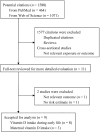Vitamin D intake and risk of type 1 diabetes: a meta-analysis of observational studies
- PMID: 24036529
- PMCID: PMC3798920
- DOI: 10.3390/nu5093551
Vitamin D intake and risk of type 1 diabetes: a meta-analysis of observational studies
Abstract
Vitamin D is suggested to have protective effects against type 1 diabetes. However, the results from observational studies have been inconsistent. We aimed to examine their association by conducting a meta-analysis of observational studies. Multiple databases were searched in June 2013 to identify relevant studies including both case-control and cohort studies. Either a fixed- or random-effects model was used to calculate the pooled risk estimate. We identified eight studies (two cohort studies and six case-control studies) on vitamin D intake during early life and three studies (two cohort studies and one case-control study) on maternal vitamin D intake during pregnancy. The pooled odds ratio for type 1 diabetes comparing vitamin D supplementation with non-supplementation during early life was 0.71 (95% confidence interval [CI], 0.51-0.98). Similar results were observed in the case-control subgroup analysis but not in the cohort subgroup analysis. The pooled odds ratio with maternal intake of vitamin D during pregnancy was 0.95 (95% CI, 0.66-1.36). In conclusion, vitamin D intake during early life may be associated with a reduced risk of type 1 diabetes. However, there was not enough evidence for an association between maternal intake of vitamin D and risk of type 1 diabetes in the offspring.
Figures
References
-
- Bin-Abbas B.S., Jabari M.A., Issa S.D., Al-Fares A.H., Al-Muhsen S. Vitamin D levels in Saudi children with type 1 diabetes. Saudi Med. J. 2011;32:589–592. - PubMed
Publication types
MeSH terms
Substances
LinkOut - more resources
Full Text Sources
Other Literature Sources
Medical



